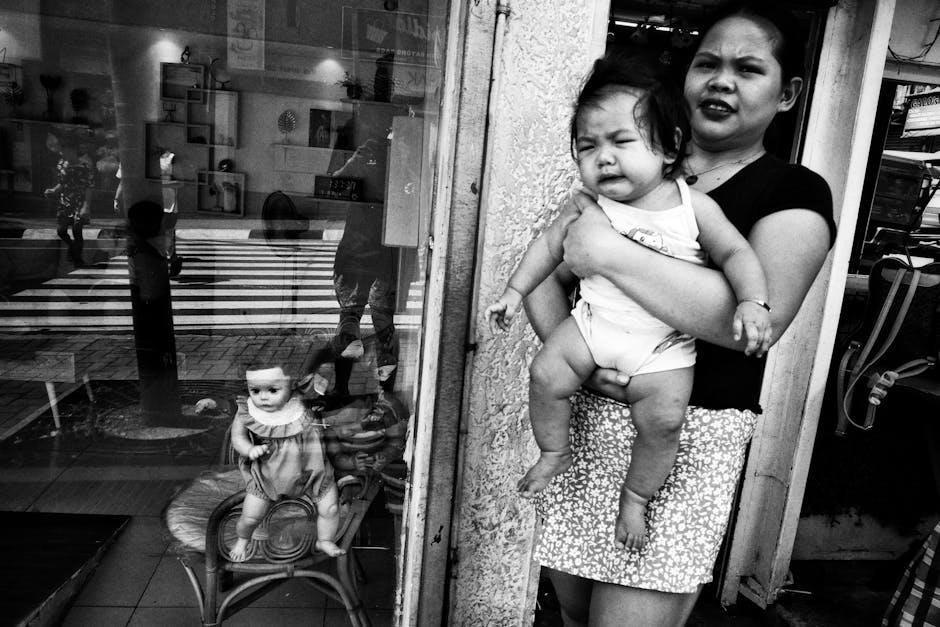Tennessee Williams’ The Glass Menagerie is a poignant memory play exploring family dynamics and unfulfilled dreams. Available as a free PDF download on platforms like archive.org and royallib.com‚ it remains a timeless classic of American literature.
Overview of the Play
Tennessee Williams’ The Glass Menagerie is a haunting memory play set in St. Louis during the Great Depression. Narrated by Tom Wingfield‚ the story revolves around the struggles of his family‚ dominated by his overbearing mother‚ Amanda‚ and his fragile sister‚ Laura. The play explores themes of illusion‚ reality‚ and escape‚ as the characters grapple with their unfulfilled aspirations. Amanda clings to her past glory‚ Laura finds solace in her glass menagerie‚ and Tom seeks freedom from his suffocating home life. The play’s poetic language and vivid imagery evoke a sense of melancholy‚ making it a timeless exploration of human frailty and family bonds.
Historical Context of the 1930s Setting
The play is set against the backdrop of the Great Depression‚ a period of economic turmoil that deeply affected American society. The Wingfield family’s struggles reflect the broader societal challenges of the 1930s‚ including unemployment‚ financial instability‚ and the decline of the middle class. Tennessee Williams vividly captures the era’s atmosphere of despair and lost hope‚ as characters like Tom and Amanda grapple with their diminished circumstances. The play’s setting in St. Louis‚ a city hit hard by the Depression‚ underscores the themes of illusion and reality‚ as the characters cling to fading dreams of prosperity and social status.
The Significance of the Title
The title‚ The Glass Menagerie‚ holds deep symbolic meaning‚ reflecting the fragility and delicacy of the characters and their lives. Laura’s collection of glass animals‚ particularly the unicorn‚ represents her vulnerability and uniqueness. The menagerie also symbolizes the family’s shattered dreams and illusions‚ as each character struggles with their own form of emotional or psychological fragility. The glass‚ like the characters‚ is easily broken‚ mirroring the precarious nature of their existence. Tennessee Williams uses the title to underscore the themes of fragility‚ escape‚ and the clash between illusion and reality‚ central to the play’s emotional landscape.
Plot Summary
The Glass Menagerie is a memory play narrated by Tom Wingfield‚ recounting his family’s struggles during the 1930s. The story revolves around Amanda‚ a dominating mother‚ her fragile daughter Laura‚ and Tom’s desire to escape their suffocating reality. The play’s climax centers on Laura’s failed encounter with Jim O’Connor‚ symbolizing shattered hopes and the family’s inability to escape their past. The narrative blends illusion and reality‚ capturing the Wingfields’ tragic quest for stability and happiness amidst economic hardship and personal dysfunction.
Structure as a Memory Play
The Glass Menagerie is structured as a memory play‚ narrated by Tom Wingfield‚ who recounts his family’s struggles in the 1930s. The play’s non-linear narrative flows through Tom’s recollections‚ blending illusion and reality. Tennessee Williams employs poetic language‚ stage directions‚ and symbolic elements like the glass menagerie to evoke a dreamlike atmosphere. The use of lighting and music enhances the emotional depth‚ while the fragmented structure mirrors the instability of the Wingfields’ lives. This format allows the audience to experience the story through Tom’s subjective lens‚ emphasizing themes of memory‚ escape‚ and the fragility of human existence.
Main Characters and Their Roles
The play revolves around four main characters‚ each representing distinct emotional and psychological struggles. Amanda Wingfield‚ the mother‚ is a controlling figure clinging to her past glory‚ desperate to secure her daughters’ futures. Tom Wingfield‚ the narrator and protagonist‚ feels trapped by his responsibilities‚ seeking escape through writing and adventure. Laura Wingfield‚ the fragile sister‚ symbolizes vulnerability and innocence‚ finding solace in her glass menagerie. Jim O’Connor‚ the gentleman caller‚ embodies lost hopes and unfulfilled aspirations‚ leaving a lasting impact on Laura. Their complex relationships and inner conflicts drive the play’s emotional depth and thematic resonance.
Key Scenes and Turning Points
The play’s pivotal moments include Tom’s opening monologue‚ setting the tone for the memory play. Laura’s delicate interaction with her glass collection highlights her fragility. The confrontation between Amanda and Tom over his job and future serves as a turning point‚ revealing deep-seated tensions. Jim O’Connor’s visit ignites hope but ultimately leads to heartbreak‚ especially when Laura’s disability is revealed. The final scene‚ where Tom deserts his family‚ underscores his escape from reality‚ leaving Amanda and Laura in despair. These scenes‚ available in the PDF version‚ encapsulate the emotional core of Williams’ masterpiece‚ exploring themes of illusion‚ escape‚ and shattered dreams.
Characters Analysis
The play examines the Wingfield family’s struggles through Amanda‚ the controlling mother; Tom‚ the conflicted narrator; Laura‚ the fragile sister; and Jim‚ the symbol of lost hopes.
Amanda Wingfield: The Mother Figure
Amanda Wingfield is the controlling‚ manipulative mother who clings to her faded Southern belle past. Her delusions of grandeur and relentless push for Laura’s marriage reflect her inability to accept reality. Amanda’s constant interference in her children’s lives stems from her own insecurities and fear of poverty. Despite her overbearing nature‚ she represents a complex mix of love‚ desperation‚ and flawed parenting. Her character underscores the theme of illusion versus reality‚ as she struggles to reconcile her past glory with the harsh present‚ ultimately contributing to the family’s dysfunction and emotional turmoil.
Tom Wingfield: The Narrator and Protagonist
Tom Wingfield is the narrator and protagonist of The Glass Menagerie‚ offering a introspective view of his dysfunctional family. He is conflicted between his responsibility to his mother and sister and his own desire for freedom. Tom’s resentment toward his job at the warehouse and his frustration with Amanda’s demands highlight his inner turmoil. His decision to leave the family‚ though necessary for his survival‚ haunts him morally. Through Tom’s narrative‚ Williams explores themes of escape‚ guilt‚ and the tension between reality and illusion‚ making Tom a deeply relatable and tragic figure in the play.
Laura Wingfield: The Fragile Sister
Laura Wingfield is portrayed as a delicate and sensitive character‚ struggling with physical and emotional disabilities. Her glass menagerie symbolizes her fragile world‚ where she finds solace and escape from reality. Laura’s shy nature and inability to connect with others highlight her vulnerability. Her mother‚ Amanda‚ pushes her to find a suitor‚ but Laura’s insecurities and lack of confidence make this daunting. Tennessee Williams uses Laura’s character to explore themes of isolation and unfulfilled hopes‚ making her one of the most poignant figures in the play. Available in PDF versions‚ Laura’s story remains a powerful exploration of human fragility.
Jim O’Connor: The Symbol of Lost Hopes
Jim O’Connor‚ the gentleman caller‚ embodies the fleeting nature of hope in The Glass Menagerie. His charm and optimism initially uplift Laura‚ but the revelation of his engagement crushes her fragile dreams. Jim represents the outside world’s harsh realities‚ contrasting the Wingfield’s escapist tendencies. His character highlights the impossibility of escaping disillusionment‚ making him a poignant symbol of lost hopes. Available in PDF formats‚ Jim’s role underscores the play’s themes of unfulfilled expectations and the fragility of human connections.

Themes and Symbolism
Tennessee Williams’ The Glass Menagerie explores themes of family dynamics‚ illusion vs. reality‚ and escape through symbols like Laura’s fragile glass collection. Available in PDF‚ it highlights Williams’ poetic portrayal of human fragility and lost hopes.

Family Dynamics and Relationships
Tennessee Williams’ The Glass Menagerie delves deeply into the intricate and strained relationships within the Wingfield family. Amanda‚ the mother‚ struggles to balance her own desires with the needs of her children‚ often suffocating them with her overbearing nature. Tom‚ the narrator‚ feels trapped by his responsibilities‚ while Laura‚ the fragile sister‚ seeks escape through her glass menagerie. The play vividly portrays the tension between love and control‚ highlighting the emotional isolation and unmet expectations that define their family bond. These dynamics are central to the play’s exploration of human frailty‚ as seen in the PDF version available on platforms like archive.org.
The Glass Menagerie as a Symbol
The glass menagerie serves as a poignant symbol in Tennessee Williams’ play‚ representing Laura’s fragility and her escape from reality. The delicate glass animals mirror her own vulnerability and isolation. The menagerie also symbolizes the family’s lost hopes and unfulfilled dreams‚ as each piece holds sentimental value tied to their past. The final scene‚ with the image of blue roses‚ underscores the impossibility of their desires. This symbolism is central to the play’s exploration of illusion versus reality‚ and the PDF version of the play‚ available on platforms like archive.org‚ allows readers to deeply analyze these motifs.
Escape and Reality: Tom’s Struggle
Tom Wingfield’s struggle between escape and reality is central to The Glass Menagerie. He feels trapped by his oppressive home life and job at the Continental Shoemakers warehouse‚ which he despises. Tom’s desire for freedom often clashes with his responsibility toward his mother and sister. His frustration is evident when he declares‚ “I’d rather somebody picked up a crowbar and battered out my brains than go back…” This internal conflict reflects his longing to break free from reality. The PDF version of the play‚ available on platforms like archive.org‚ highlights Tom’s emotional turmoil and his ultimate decision to abandon his family‚ symbolizing his escape from reality.
Illusion vs. Reality in the Play
The Glass Menagerie masterfully explores the theme of illusion vs. reality through its characters’ struggles. Amanda clings to illusions of her past grandeur‚ while Laura escapes reality through her glass menagerie. Tom‚ the narrator‚ oscillates between his family’s fantasies and his own desire for freedom. The play’s use of dimming lights and symbolic imagery‚ such as the blue roses‚ underscores the fragility of illusion. The PDF version‚ available on platforms like archive.org‚ reveals how Williams uses poetic language to blur the lines between illusion and reality‚ creating a poignant commentary on human frailty and the escapism that defines the Wingfield family’s existence.
Writing Style and Literary Devices
Tennessee Williams employs poetic language and vivid imagery in The Glass Menagerie. His nonlinear narrative structure and symbolic elements‚ like Laura’s glass animals‚ enhance the play’s emotional depth‚ as seen in the PDF version.
Use of Poetic Language
Tennessee Williams’ poetic language in The Glass Menagerie creates vivid imagery and emotional depth. His descriptive prose‚ such as the “blue roses” and Laura’s delicate glass animals‚ evokes a haunting beauty. The play’s dialogue is rich with metaphorical expressions‚ like Tom’s comparison of the warehouse to a “celotex interior‚” which underscores his suffocation. Williams’ lyrical style‚ evident in the PDF version of the play‚ immerses readers in the Wingfield family’s fragile world‚ blending reality with illusion. This poetic approach enhances the play’s themes of longing and escape‚ making it a masterpiece of American literature.
Nonlinear Narrative Structure
Tennessee Williams employs a nonlinear narrative in The Glass Menagerie‚ blending past and present through Tom’s memories; The play’s structure mirrors the fragmented nature of recollection‚ with scenes unfolding out of chronological order. This fluid‚ memory-driven approach creates a dreamlike atmosphere‚ emphasizing emotional resonance over linear storytelling. The PDF version of the play preserves this structure‚ allowing readers to experience the interplay of past and present. Williams’ use of stage directions and visual cues‚ such as the screen images‚ further enhances the nonlinear format‚ making it a defining feature of the play’s artistic brilliance and emotional depth.
The Role of Music and Lighting
Music and lighting in The Glass Menagerie are essential for setting tone and mood‚ as evident in the PDF versions of the play. Music cues‚ such as the record Laura plays‚ create emotional depth and synchronize with key moments‚ like her polishing glass figures. Lighting dynamically shifts to reflect the characters’ inner states‚ with dimming scenes symbolizing their fading hopes. The iconic image of blue roses illuminated on the screen underscores Laura’s fragility. These elements‚ preserved in digital formats‚ enhance the play’s poetic and atmospheric quality‚ making them integral to its dramatic impact and lasting appeal in both stage and written forms.

Historical and Cultural Relevance
The Glass Menagerie reflects 1930s America’s economic struggles and social isolation‚ capturing the Great Depression’s impact on middle-class families. Its themes of disillusionment and escapism resonate deeply‚ making it a significant cultural artifact available in PDF for modern study.
The Play’s Reflection of the Great Depression
The Glass Menagerie vividly portrays the economic hardships and social struggles of 1930s America‚ mirroring the Great Depression’s impact on families. The Wingfield family’s financial instability‚ Tom’s discontent with his job‚ and Amanda’s nostalgic longing for a lost prosperity resonate with the era’s widespread disillusionment. Williams captures the stifling reality of unemployment‚ declining middle-class hopes‚ and the emotional toll of economic failure. The play’s setting and characters reflect the broader societal struggles‚ offering a poignant glimpse into a nation’s collective despair. Available as a PDF‚ it remains a powerful resource for studying this pivotal historical period through literature.
Social Issues of the 1930s in America
The Glass Menagerie highlights the social struggles of 1930s America‚ including unemployment‚ poverty‚ and gender inequality. The Wingfield family’s financial instability mirrors the era’s economic crisis‚ while Amanda’s clinging to past glory reflects the decline of the Southern aristocracy. Tom’s frustration with his job and Laura’s isolation due to her disability underscore the societal challenges of the time. The play also explores the tension between illusion and reality‚ as characters cope with unfulfilled hopes. These themes‚ available in the PDF version‚ provide insight into the social fabric of America during the Great Depression‚ revealing the human cost of economic collapse and societal expectations.
Cultural Impact of the Play
Tennessee Williams’ The Glass Menagerie has left an indelible mark on American literature and theater. Its exploration of family dynamics‚ mental health‚ and societal pressures resonated deeply with audiences‚ making it a cornerstone of 20th-century drama. The play’s poetic language and nonlinear narrative influenced countless writers and playwrights. Its themes of illusion vs. reality and escape from hardship continue to captivate readers and viewers. Available as a PDF‚ the play remains widely studied in schools and universities‚ ensuring its cultural relevance endures. Its impact is evident in adaptations‚ scholarly discussions‚ and its lasting presence in the literary canon.

PDF and Digital Availability
The Glass Menagerie is widely available as a free PDF download on platforms like archive.org and royallib.com‚ in formats like EPUB and MOBI for easy access.
How to Download the PDF Version
To download The Glass Menagerie in PDF format‚ visit platforms like archive.org or royallib.com. Search for the play‚ select your preferred format (PDF‚ EPUB‚ or MOBI)‚ and click the download link. For large files‚ consider using a download manager like JDownloader to avoid interruptions. Once downloaded‚ use an ebook reader such as Annas Archive‚ ReadEra‚ or Calibre to open the file. Ensure you have the necessary software installed to view the content. For convenience‚ direct links to the PDF version are available on trusted sites‚ making it easy to access Tennessee Williams’ classic play digitally.
Popular Platforms for Accessing the Play
The Glass Menagerie is widely available on platforms like archive.org‚ royallib.com‚ and Google Books. These sites offer free or low-cost access to the PDF version of the play. Additionally‚ platforms like Project Gutenberg and ManyBooks provide digital versions for easy reading. Users can also find the play on academic databases or through ebook stores like Amazon or Kobo. These platforms ensure that Tennessee Williams’ classic work remains accessible to readers worldwide‚ making it easy to explore its poignant themes and vivid characters in a convenient digital format.
Legal and Free Sources for Download
The Glass Menagerie can be legally downloaded for free from trusted platforms like archive.org and royallib.com. These sites offer PDF versions of the play in compliance with copyright laws. Additionally‚ platforms like Project Gutenberg and ManyBooks provide free access to classic works‚ ensuring legal and safe downloads. Users can also explore academic databases or public libraries for free digital copies. Always verify the credibility of the source to avoid unauthorized versions‚ ensuring a lawful and hassle-free reading experience of Tennessee Williams’ timeless masterpiece.
Study and Analysis Resources

The Glass Menagerie study guides‚ critical essays‚ and discussion questions are widely available in PDF format. Platforms like archive.org offer free resources for deeper analysis.
Study Guides and Summaries

Study guides and summaries of The Glass Menagerie are readily available in PDF format‚ offering in-depth analyses of characters‚ themes‚ and plot structure. These resources‚ accessible on platforms like archive.org and educational websites‚ provide detailed insights into Tennessee Williams’ use of poetic language and memory play techniques. Summaries often include scene-by-scene breakdowns‚ while study guides highlight key symbols‚ such as the glass menagerie itself‚ and explore the play’s historical context. These materials are invaluable for students and educators‚ facilitating a deeper understanding of the play’s complex dynamics and emotional resonance.
Critical Essays and Analysis
Critical essays and analyses of The Glass Menagerie delve into its thematic depth‚ exploring illusion vs. reality‚ family dynamics‚ and the struggle for escape. Scholars examine Tennessee Williams’ poetic language and the play’s nonlinear structure‚ emphasizing its emotional and psychological complexity. Essays often focus on the symbolism of Laura’s glass menagerie‚ representing fragility and unfulfilled hopes. Available in PDF format on platforms like archive.org‚ these analyses provide rich interpretations of characters like Amanda‚ Tom‚ and Laura‚ offering insights into the play’s enduring relevance and its reflection of 1930s America’s social and economic challenges.
Discussion Questions and Themes
The Glass Menagerie invites readers to explore themes of illusion vs. reality‚ family dynamics‚ and the struggle for escape. Discussion questions often focus on the symbolism of Laura’s glass collection‚ representing fragility and unfulfilled hopes. Themes of memory and its distortion are central‚ as Tom’s narration blurs truth and fiction. Questions may include: How does Amanda’s past shape her present? What role does Jim play in Laura’s life? How does the play reflect the societal challenges of the 1930s? Available in PDF format‚ these questions encourage deeper analysis of Williams’ poignant portrayal of human frailty and resilience.

Modern Relevance and Adaptations
The Glass Menagerie remains a timeless classic‚ with its themes of family dysfunction and escapism resonating today. Stage and screen adaptations continue to captivate audiences‚ ensuring its enduring relevance.
Contemporary Interpretations of the Play
Today‚ The Glass Menagerie is reimagined through diverse lenses‚ blending traditional theater with modern artistic styles. Directors often emphasize the psychological depth of characters‚ exploring themes like mental health and societal pressures. The play’s universal appeal allows it to transcend time‚ resonating with contemporary audiences facing similar struggles. Digital adaptations and multimedia productions have also emerged‚ offering fresh perspectives on Williams’ classic. Educational institutions frequently incorporate the play into curricula‚ fostering critical discussions about family dynamics and identity. Its enduring relevance underscores its ability to evoke empathy and reflection in both traditional and innovative formats.
Stage and Screen Adaptations
The Glass Menagerie has been adapted into numerous stage productions and screen versions‚ each capturing its emotional depth and poetic essence. The 1950 film adaptation‚ starring Jane Wyman‚ remains a classic interpretation. Modern stage productions often experiment with minimalist sets and innovative lighting to emphasize the play’s symbolic elements. Screen adaptations have also evolved‚ incorporating cinematic techniques to enhance the dreamlike quality of Tom’s memories. These adaptations faithfully preserve Williams’ original dialogue while offering fresh visual interpretations‚ ensuring the play’s timeless themes continue to resonate with contemporary audiences. Its universal appeal makes it a favorite for both theatrical and cinematic reimagining.
Educational Use in Schools and Universities
Educational Use in Schools and Universities
The Glass Menagerie is widely studied in educational institutions for its rich themes and literary depth. PDF versions of the play are often used in classrooms‚ providing students with easy access to the text. Educators appreciate its exploration of family dynamics‚ memory‚ and illusion vs. reality‚ making it a valuable resource for teaching dramatic literature. Study guides and summaries available online further enhance its educational utility‚ helping students analyze characters and symbols. The play’s universal themes ensure its relevance in both high school and university curricula‚ fostering critical thinking and emotional understanding among learners.
The Glass Menagerie remains a timeless exploration of family‚ memory‚ and illusion. Its availability as a PDF ensures accessibility‚ inviting readers to experience its enduring emotional depth and historical relevance.
Final Thoughts on the Play’s Significance
Tennessee Williams’ The Glass Menagerie is a profound exploration of family dynamics‚ memory‚ and illusion. Its poignant portrayal of the Wingfield family’s struggles resonates deeply‚ capturing the fragility of human existence. The play’s use of symbolism‚ particularly the glass menagerie‚ underscores themes of fragility and unfulfilled hopes. As a memory play‚ it offers a unique narrative perspective‚ blending past and present. Widely studied and admired‚ it remains a cornerstone of American literature. Its availability in PDF format ensures accessibility for readers worldwide‚ preserving its legacy and allowing new generations to connect with its timeless themes.

Encouragement to Read or Watch the Play

Tennessee Williams’ The Glass Menagerie is a deeply moving and thought-provoking play that captivates audiences with its emotional depth and vivid characters. Reading or watching it offers a powerful exploration of family dynamics‚ illusion‚ and the fragility of human hopes. The play’s poetic language and symbolic elements‚ such as Laura’s glass menagerie‚ provide layers of meaning that resonate long after the story ends. With its availability as a free PDF download and various stage and screen adaptations‚ it’s easily accessible to everyone. Engaging with this timeless classic is an enriching experience that invites reflection on the human condition.
